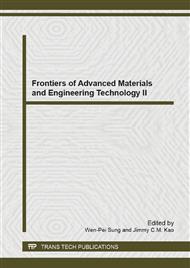[1]
P.O. Fanger. Thermal comfort. McGraw-Hill, (1970).
Google Scholar
[2]
A. PGagge J.A.J. Stolwijk, and Y. Nishi. An effective temperature Scale Based on a simple model of human physiological regulatory response. ASHRAE Transactions, 77, Part 1: 247-262, (1971).
Google Scholar
[3]
MacArthur J. W, Humidity and predicted-mean-vote based (PMV based) comfort control [J] ASHRAE Trans 1986, 92(1B): 5-17.
Google Scholar
[4]
Scheatzle D. G, The development of PMV-based control for a residence in a hot and arid climate [J], ASHRAE Trans 1991, 97(2): 1002-1019.
Google Scholar
[5]
MM Gouda, S Danaher, CP Underwood, Thermal comfort based fuzzy logic controller. The Chartered Institution of Building Services Engineers 2001, 237-253.
DOI: 10.1177/014362440102200403
Google Scholar
[6]
Dong Hwa Kang a, Paek Hyoun Moa, etc. Effect of MRT variation on the energy consumption in a PMV-controlled office [J],Building and Environment 45 (2010) 1914-(1922).
DOI: 10.1016/j.buildenv.2010.02.020
Google Scholar
[7]
Vapnik V. The Nature of Statistical Learning Theory [M]. New York: Springer Verlag, (1995).
Google Scholar
[8]
Xu Wei, CHEN Xiang-guang, PMV index forecasting system based on fuzzy C-means clusting and support vector machine[J], System Engineering-Theory & Practice, 2009, 29(7), 119-124.
Google Scholar
[9]
SUN Bing, Jiang Neng-fei, Application of Least Square Support Vector Machine to Predict Thermal Comfort Index[J], Building Science, 2011, 27(8), 66-69.
Google Scholar
[10]
L. Wang, C. Singh, PSO-based Hybrid Generating System Design Incorporating Reliability Evaluation and Generation/Load Forecasting, Power tech conference, 2007, IEEE Lausanne.
DOI: 10.1109/pct.2007.4538519
Google Scholar
[11]
Eberhart RC, Kennedy J. A new optimizer using particle swarm theory. In: Proc. ISMMH S. 1995. p.39–43.
Google Scholar


